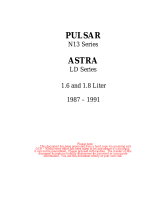
3.1.10. Crank the engine for at least five compression strokes, or until the pressure reading on the gauge stops rising.
3.1.11. Record the compression reading, then push the side release valve to relieve the pressure.
3.1.12. Repeat the test and record the reading. Relieve the pressure and remove the hose from the spark plug well.
3.1.13. Repeat paragraphs 3.1.8 to 3.1.12 for the remainder of the cylinders.
3.2. VALVE SEAL AND SPRING REPLACEMENT
3.2.1. Turn the engine so that the piston of the cylinder to be worked on is at Top Dead Centre (TDC), with both valves closed.
3.2.2. Choose the proper spark plug hose and remove the valve core from the end.
3.2.3. Thread the spark plug hose into the spark plug hole of the subject cylinder.
3.2.4. Connect the garage air supply and apply air pressure.
NOTE: If the garage air hose uses a different quick coupler system than the spark plug hose, use the quick coupler of the VSE206 kit and
attach it to the garage air hose.
3.2.5. Replace the seals and springs as required, with the air pressure holding the valves closed.
3.2.6. Disconnect the spark plug hose at the quick coupler.
3.2.7. Carry out the same procedure on each cylinder that requires valve parts replacing.
4. TEST RESULTS
4.1. GAUGE READINGS
4.1.1. On a normal cylinder, the gauge needle should travel up the scale on each compression stroke until it reaches peak value. All cylinders
should indicate a pressure that is within the vehicle manufacturer’s specifications, and the reading should not vary by more than 10%
from cylinder to cylinder.
4.1.2. If the gauge needle does not travel up the scale, or if it remains at the same value for several strokes and then starts to climb, the problem
could be a valve sticking.
4.1.3. If the compression reading is considerably higher than the vehicle manufacturer’s specification, the problem may be carbon build-up in
the cylinder. It may also indicate that either the piston, or the cylinder head, has been modified.
4.1.4. If a reading on two adjacent cylinders is 20 psi (or more) lower than the other cylinders, the problem may be a cracked cylinder head or
defective main gasket. Under these conditions, both coolant and oil may be found in both cylinders under these conditions.
4.1.5. If the readings are low, or vary widely between cylinders, pour a teaspoon of SAE 30 oil into each cylinder and retest them. If the readings
increase considerably, the problem may be poorly seated, or worn, piston rings. If the readings remain about the same, the valves and/or
associated components may be the problem. A burned or damaged piston may also cause the same results.
5. COMPLETION OF TESTS
5.1. Clean, re-gap and reinstall the spark plugs in the same order in which they were removed, or install new spark plugs.
5.2. Reconnect each spark plug wire to the plug it was connected to prior to removal.
5.3. Return the throttle plates to the closed position.
IMPORTANT: After test, failure to return the throttle plates to the closed position before starting the engine can cause serious damage to
the engine.
5.4. Reconnect the ignition system wiring disconnected at paragraph 3.1.7.
5.5. Repeat paragraphs 3.1.8 to 3.1.12 for the remainder of the cylinders.
.
Original Language Version
© Jack Sealey Limited
Sealey Group, Kempson Way, Suffolk Business Park, Bury St Edmunds, Suffolk. IP32 7AR
01284 757500 sales@sealey.co.uk www.sealey.co.uk
ENVIRONMENT PROTECTION
Recycle unwanted materials instead of disposing of them as waste. All tools, accessories and packaging should be sorted,
taken to a recycling centre and disposed of in a manner which is compatible with the environment. When the product
becomes completely unserviceable and requires disposal, drain any fluids (if applicable) into approved containers and
dispose of the product and fluids according to local regulations.
Note: It is our policy to continually improve products and as such we reserve the right to alter data, specifications and component parts without prior
notice.
Important: No Liability is accepted for incorrect use of this product.
Warranty: Guarantee is 12 months from purchase date, proof of which is required for any claim.
REGISTER YOUR
PURCHASE HERE
VSE206 Issue 2 (H, F) 23/03/23



